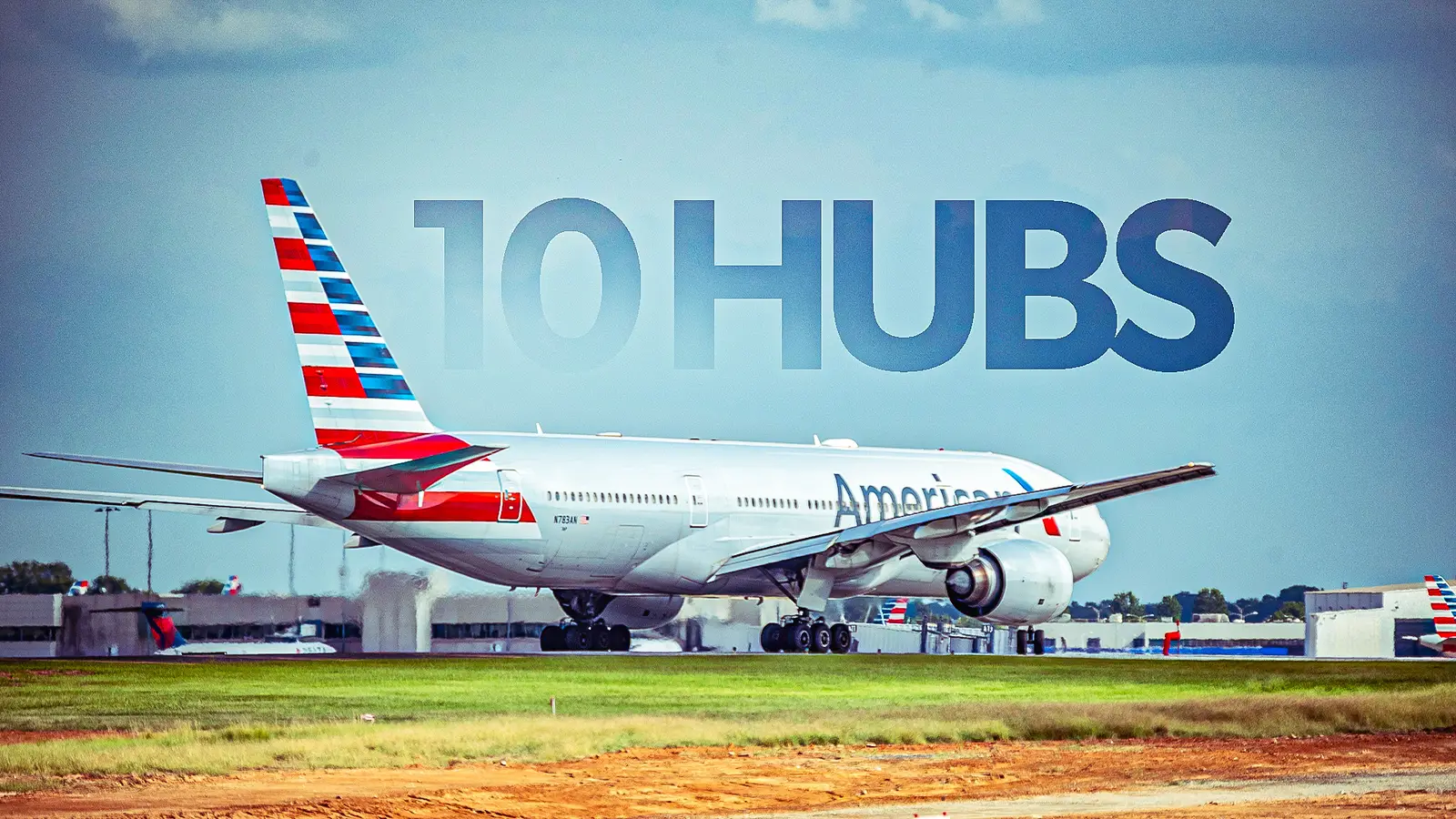Copyright Simple Flying

As one of the largest airlines in the US, American Airlines provides services that connect every corner of the country. As a result, the airline has a large number of hubs to help achieve this, ten to be exact. When compared to their ferocious competitors, this number is far greater than the rest, allowing American to fly the flag at the top of the list not just in the US, but also in the world. While Delta may have the largest hub in terms of size, the scale of American’s hub-and-spoke operations remains unmatched. Other airlines across the world are able to be greatly successful with fewer hubs than American, so why do they need so many hubs? Hubs are centralized, strategic locations which airlines can utilize to help route passengers between regional airports and international destinations, allowing for greater reach across the airline’s entire route network. For American, as the world’s largest airline, by multiple metrics including fleet size, passengers, and network, being able to connect its network as seamlessly as possible is no ordinary feat and has required careful planning over decades to bring it to the position it sits in today. This article will explain how and why American Airlines has developed so many hubs, exploring the network’s history, geography, and business strategy. A Network Built On Scale, Geography, And History There are a wide range of reasons why American Airlines has so many hubs in its network. Primarily, it comes down to three main factors: strategic mergers, geographic coverage, and traffic management. Each individual hub supports a different part of its vast network, ranging from domestic connections in Charlotte and Phoenix to international operations in Miami and Dallas/Fort Worth, the latter being the largest of its hub airports. The hub system allows American to connect more than 350 destinations worldwide with efficient scheduling, maximizing what can be made possible with the resources they have available. Simply put, the large number of hubs maximizes reach and flexibility in both US and global markets and is the key to the success of the airline. To understand the role each hub plays, it is important to first understand the importance of Dallas/Fort Worth (DFW). The airport serves as the airline’s “superhub,” with over 930 daily flights to more than 230 destinations in 30 countries, making it the focal point across the entire route network. Supporting DFW, Miami (MIA) acts as the Latin American gateway, while Charlotte (CLT) dominates East Coast and Caribbean connections. Other hubs like Phoenix (PHX), Philadelphia (PHL), and Chicago O’Hare (ORD) keep the national network balanced across time zones and regions. While DFW handles the majority of traffic, each other hub has a primary focus and function that adds to the giant aviation puzzle of the American Airlines network, with even just one missing having significant consequences for every other hub. The multi-hub structure is partly inherited from past mergers, especially with US Airways and America West. These mergers added CLT, PHL, and PHX to American’s roster. Today, the system is coordinated through American’s Integrated Operations Center in Fort Worth, which manages nearly 6,000 flights per day across its 1,500-aircraft fleet. So, Why Ten Hubs? As mentioned previously, strategic mergers, geographic coverage, and traffic management all have a significant role in how American Airlines operates. Each factor shapes where and how the airline can efficiently move passengers and cargo across its network. In addition, market demand and airport accessibility also have an influence over network decision-making and have helped steer the airline on the path that it has followed up to the present day. So let's break down these factors to help provide clarity. Firstly, in terms of geography, America’s size makes coast-to-coast coverage essential. DFW sits at the center, while MIA, CLT, and PHX cover regional extremes. As a result of the airline's mergers, US Airways and America West brought existing hub systems into the fold, further expanding the airline's footprint and providing a much greater strategic advantage. Regarding airport constraints, some major airports such as DCA, LGA, and JFK have slot restrictions, so maintaining operations there preserves access to critical business markets that would otherwise be difficult to tap into if their presence weren't already a reality. The final key area is demand distribution. Each hub fundamentally reflects the local population and travel needs. Simply, ORD for the Midwest, PHL for transatlantic, MIA for Latin America, and LAX for Pacific routes. American’s hub system is designed to feed and connect traffic efficiently, which is central to the success of this network strategy. For example, CLT’s schedule groups hundreds of flights within short windows to maximize connection opportunities, which is known as "banking". Meanwhile, DFW’s central location minimizes flight times across the country, and MIA’s Latin routes reflect decades of dominance in the Caribbean and South American markets, allowing for a greater sphere of influence beyond US territory. Inside American’s Strategy American Airlines’ official fact sheets describe each hub as an “economic engine” for its region, emphasizing the airline’s long-term investment in each city and the importance that each city has individually. Executives have stated that the company’s network strength relies on connecting communities rather than concentrating on one or two locations. For American, scale and quantity are king. According to the airline, 82% of all passenger traffic at DFW is provided by American, employing over 30,000 team members in the area. CLT employs 15,000 in North Carolina, and MIA has more than 13,000 across Florida. What is evident is that this distributed hub system allows American to adjust capacity and shift demand more smoothly than carriers dependent on a single superhub. Most importantly, they have the ability to spread the load and strain of their vast operations across their hubs in a way that still retains maximum efficiency. This approach supports economic development and operational stability. During disruptions or regional downturns, American can reroute traffic through alternate hubs to maintain service continuity, something competitors with fewer hubs find harder to achieve. In an age where legacy carriers have been challenged globally by rapidly growing low-cost and hybrid carriers, this establishment of a well-planned and intricately crafted network is something that sets American apart from its competition. Fierce Competition In The Skies Compared to Delta and United, American Airlines has one of the broadest hub footprints. Delta relies heavily on Atlanta, while United concentrates traffic through Chicago, Houston, and Denver. When compared with American, this is a very minimal hub spread. American’s wider spread provides more geographic reach but also adds complexity, meaning that the airline must ensure that scheduling and route planning are carried out effectively. The key principal benefit is flexibility. If weather or congestion affects one hub, others can absorb traffic. The drawback is that costs and staffing demands are higher, and so with that, there is a requirement for maximal efficiency from employees as well as a streamlined financial strategy. Maintaining a balance across ten cities requires precise coordination, and not all hubs deliver equal profitability year-round. While Delta may operate more efficiently through Atlanta in comparison, American’s distributed model ensures a national presence that reaches nearly every major metro area. It is very difficult to find any area in the US where the airline does not have a presence. That broader access helps American compete for both leisure and corporate travelers across all regions, effectively allowing them to reach everyone in the nation. The Challenges Of Running So Many Hubs Having many hubs brings operational and financial challenges. Complex scheduling, weather disruptions, and regional overlaps can strain resources and efficiency. As a result, operating in the way that American Airlines does brings with it a significant amount of risk. Any potential shortcoming or unexpected failure could have major, long-lasting effects on the airline as a whole. As an example, PHL and JFK both serve transatlantic markets, creating some overlap. Slot-restricted airports like DCA and LGA limit expansion potential, even when demand is strong. Likewise, smaller hubs such as PHX can face capacity limits during peak periods. Each of these can be considered as hypothetical 'fault lines' in which, if even just a single one has a failure or incident that harms operations, eventually this will spread to all the others, causing a knock-on effect across all vulnerable areas and therefore the entirety of the network. While the hub model enhances connectivity, travelers should be aware that disruptions at one hub can cause system-wide ripple effects, regardless of where the initial disruption occurred. Still, American’s Integrated Operations Center, which is equipped with AI-driven HEAT tools and predictive maintenance, can help to minimize those impacts. A System That Defines American Airlines’ Strength American Airlines’ system of ten hubs is the result of strategic growth and historical evolution. It allows the carrier to maintain dominance across the US while serving global markets efficiently. It is not a bragging right as a record holder; it is a carefully planned and intentional decision from the airline to maximize their operational potential. Each hub plays a specific role: DFW anchors global operations, CLT powers domestic connections, MIA dominates Latin America, and the coastal airports (LAX, JFK, PHL) link the world. This distributed model keeps American competitive and resilient, especially in the face of ever-changing and evolving competition. Looking ahead, American is more likely to optimize existing hubs by adding capacity at DFW, CLT, and MIA rather than building new ones. Its Integrated Operations Center will continue to serve as the network’s “brain,” ensuring that all ten hubs operate as one unified system. It remains to be seen whether other airlines will try to emulate this strategy, but for now, American is still the only global airline to have this many hubs.



